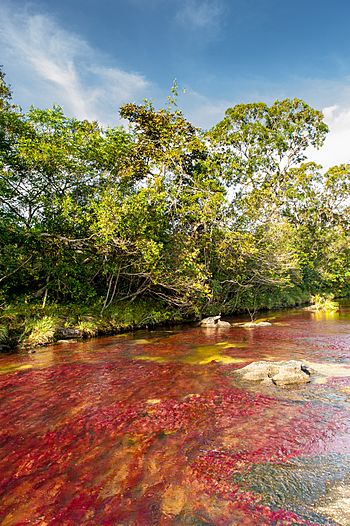Caño Cristales facts for kids
Quick facts for kids Caño Cristales |
|
|---|---|

Caño Cristales
|
|
| Lua error in Module:Location_map at line 420: attempt to index field 'wikibase' (a nil value). | |
| Other name(s) | liquid rainbow, river of five colours |
| Country | Colombia |
| Department | Meta |
| Physical characteristics | |
| Main source | Serranía de la Macarena |
| River mouth | Guayabero River |
| Length | 100 km (62 mi) |
The Caño Cristales is a special river in Colombia. Its name means "Crystal Channel" (English: "Crystal Channel"). It flows into the Guayabero River, which is part of the larger Orinoco basin. This amazing river is often called the "River of Five Colors" or the "Liquid Rainbow." It is famous for its bright and striking colors.
From late July through November, the riverbed turns many colors. You can see yellow, green, blue, black, and red. In recent years, many people have wanted to visit this beautiful river. In 2016, over 16,000 visitors came to see its unique beauty.
Contents
What Makes Caño Cristales Unique?
The Caño Cristales is a fast-flowing river. It has many exciting rapids and waterfalls. You can also find small, round holes in the riverbed. These are called giant's kettles. They form when small rocks or pebbles get stuck in a hollow. The water current spins them around, slowly carving out a bigger, deeper hole.
Plants and Animals of the River
The Caño Cristales is home to different kinds of fish. You can also find freshwater turtles and other water animals here. The river also has many types of aquatic plants.
The most famous plant is Rhyncholacis clavigera. This plant is what gives the river its amazing red color. When the plants are young, they are green. Then they turn yellowish. Finally, they become different shades of red. This happens from July to November, making the river look like a rainbow.
Fun Facts About Caño Cristales
- The Caño Cristales is located in the Serranía de la Macarena. This is an isolated mountain range in Colombia.
- A group of cattle farmers first discovered the river in 1969.
- The river's bright red color comes from a special plant. This plant is called Rhyncholacis clavigera. It grows in large amounts on the riverbed.
See also
 In Spanish: Caño Cristales para niños
In Spanish: Caño Cristales para niños


